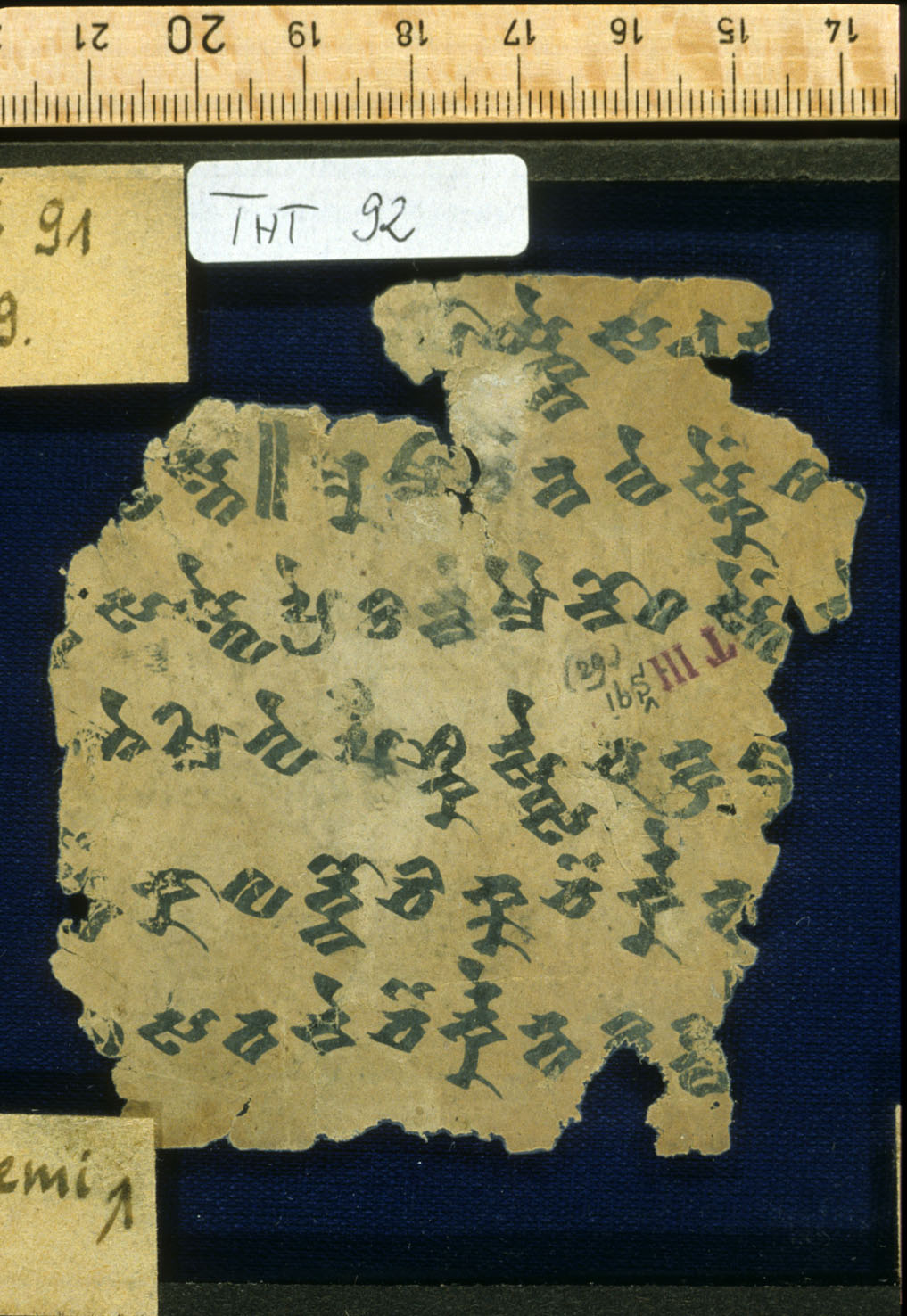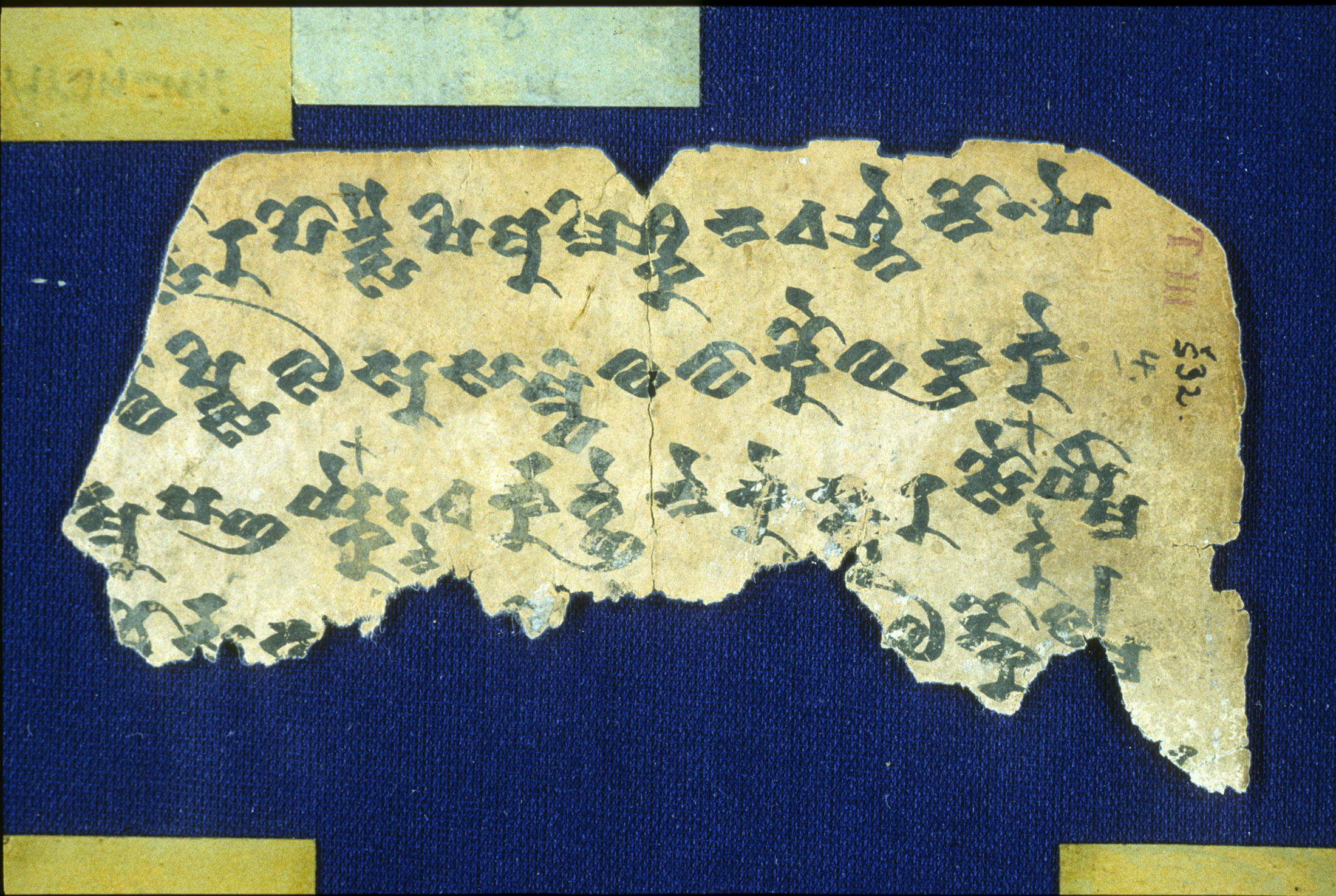THT 92
| Known as: | THT 92; B 92; Bleistiftnummer 2327 |
|---|---|
| Cite this page as: | Melanie Malzahn. "THT 92". In A Comprehensive Edition of Tocharian Manuscripts (CEToM). Created and maintained by Melanie Malzahn, Martin Braun, Hannes A. Fellner, and Bernhard Koller. https://cetom.univie.ac.at/?m-tht92 (accessed 14 Jul. 2025). |
Edition | |
| Editor: | Melanie Malzahn |
Provenience | |
| Main find spot: | Shorchuk |
| Expedition code: | T III Š 91.29, T III Š 32.4 |
| Collection: | Berlin Turfan Collection |
Language and Script | |
| Language: | TB |
| Linguistic stage: | classical |
| Script: | classical |
Text contents | |
| Title of the work: | Araṇemijātaka |
| Text genre: | Literary |
| Text subgenre: | Jātaka/Avadāna |
| Verse/Prose: | prose; verse |
| Meter: | 4343 (4x) |
Object | |
| Manuscript: | Araṇemi α |
| Preceding fragment: | THT 91 |
| Following fragment: | THT 93 |
| Material: | ink on paper |
| Form: | Poṭhī |
| Number of lines: | 6 |
Images
Images from idp.bl.uk by courtesy of the International Dunhuang Project, the Berlin-Brandenburgische Akademie der Wissenschaften, and the Staatsbibliothek zu Berlin – Orientabteilung.
Transliteration
(continues from THT 91)
| a1 | /// po ykne sa e [n](·) /// |
|---|---|
| a2 | /// (·)[w](·) st[e] || a mā cä nta we skeṃ sa – /// |
| a3 | /// (·)[tra] sa swe pre ka nne mai no sa sweṃ [t](·)e (– –) (·)[la] [s̝]s̝a· || (– – – – – – –) a ra – |
| a4 | /// ṇe mi we rpi śka tstse ca ndra mu (– –) [n]t(·) ka rtte yku we rm(·)ṃ a sāṃ ño rṣ[a] ma[ṃ] || tu meṃ |
| a5 | /// stä kā wa tno ci kka cä rke nta /// /// a ñca lī ṣa rne yā mu a ra ṇe mi we s̝s̝aṃ |
| a6 | /// [tu] sa ta ne cä rke nta ka ll(·) (– –) ne ca ndra mu khe wa lo a ra ṇe miṃ tsa wa |
| b1 | /// [ye] rpe sa me ñpa lle [n]tn(·) ṣ(·) (– – – –) [nt]s[o] ra po ntsai ṣi a mi śka na e śne no • ṣe |
| b2 | /// ·t[a] ññe ñe mmā ṣāṃ ste kā ka [tsi] (– –) [ṣ]w(·) ṣtsi au su sa¯ ¯mp• wa wā kau wa ku ke |
| b3 | /// rne : ya kte ta pre ke ktseṃ tsa pre (– –) nmu ṣa¯ ¯ñ yke «ne» : e rka tñe ne ke kmu ra sau «ke» ymī |
| b4 | /// m· lyka śkaṃ lkā n[ta] rne : ka rpyeṃ ś[w](·) (– –) [ś](·)o rsa [t](·) (– –) – (– – – –) o ṅko lma |
| b5 | /// – yā ms̝aṃ ma ñye[ṃ] tsñi : tseṃ u [p](·) /// |
| b6 | /// [ma] nta ntra po [ścwi] /// |
(continues on THT 93)
Transcription
(continues from THT 91)
| a1 | /// po-yknesa en·° /// |
|---|---|
| a2 | n1 /// ·w· ste ॥ amācänta weskeṃ sä(sweṃ) /// |
| a3 | n2 /// ·trä saswe prekän-ne mai no säsweṃt(s)e – · (āk)läṣṣä(ṃ) ॥ – – – – – – – ara(ṇe)¬ |
| a4 | (mi) /// (ara)ṇemi werpiśkatstse candramu(khi) (lā)nt(e) =kartte ykuwerm(e)ṃ asāṃ ñor ṣamäṃ ॥ tumeṃ |
| a5 | /// (ne)st{†ä} kā wat no ci kka cärkenta (kalatsi) (yātka) (॥) añcalī ṣarne yāmu araṇemi weṣṣäṃ |
| a6 | /// tusa tane cärkenta käll(āskau) (॥) (ta)ne candramukhe walo araṇemiṃtsa wa¬ |
| b1 | (lke)n3 (pilko) (śeśśamormeṃ) /// (॥) |
| 1a | (särwānaṣṣe) ; yerpesa ; meñ pällentn(e) ; ṣ(eṣṣirku) (:) |
|---|---|
| 1b | (wnolme)ntso ra ; ponts aiṣi ; amiśkana ; eśne no • |
| 1c | ṣe b213σ /// |
| 1d | – – – – (pos)taññe ; ñem mā =ṣāṃ ste ; kākatsi |
| 2a | (kärsto)ṣ w(a){ṣ→s}tsi ; ausu samp ; wawākauwa ; kukeb3(ne)n4n5 |
| 2b | 13σ /// rne : |
| 2c | yak te tapre ; kektseṃtsa ; pre(ñca) (yai)nmu ; ṣañ ykene : |
| 2d | erkatñene ; kekmu ra ; sauke ymīb4(ye)n6 ; (mäsketär) |
| 3a | 8σ /// m· 1σ lykaśkaṃ ; lkāntar-ne : |
| 3b | kärpyeṃ św(ātsi) ; (śe)ś(w)orsa ; t· – – – – 4σ ; – – – |
| 3c | oṅkolmab5(ntse) ; 10σ |
| 3d | 7σ /// ; – – yāmṣäṃ ; mañyeṃts ñi : |
| 4a | tseṃ up(pāl-yok) /// 10σ |
| 4x | b6/// mäntanträ poś cwi /// |
(continues on THT 93)
Translation
(continues from THT 91)
| a1 | ... in any way ... |
|---|---|
| a2 | ... is (the lord ?). The ministers speak: “The l(ord ?) ... |
| a3 | ... “The lord shall ask him! Surely he will (teach ?) ... from to the lord." || ... Ara(ṇemi) |
| a4 | ... The gardener (Ara)ṇemi, having come close[er] to the (ki)ng Candramu(kha), sits [down] at the foot of the throne. Thereupon |
| a5 | ... you (a)re; or why (has he) just (commanded) you, (to bring) garlands?” With folded hands Araṇemi speaks: |
| a6 | “ .... Therefore (I) bring the garlands here." Then the King Candramukha (having directed [his] gaze ?) lo(ng) at Araṇemi, .... |
| b1 | ... || His round (face) [has] (surpassed) [that of] the moon [when being] full moon. To all (creatures) he gave [gifts], for the eyes are hopeless. One |
| b2 | ... The name (overlord)ship must not be named. (1.) With (torn) garment that one [is] clothed. Cracked [are his] heel(s). |
| b3 | .... Still tall in body he himself (achie)ved bea(ring) in his stead. Even if fallen into contempt, his [life] path (is) steady (??). (2.) |
| b4 | ... they are seen [as] small on him. By the eating of mean food ... . (Of ?) the elephant |
| b5 | ... he does (the service) of my servants. (Like?) the blue lotus .... |
| b6 | ... he is evil-minded. To each of this one’s .... |
(continues on THT 93)
Commentary
Philological commentary
| The translation basically follows Schmidt 2001: 322-3. | |
| The text is sloppily written. Some akṣaras were omitted or spelled wrongly. | |
| According to Sieg/Siegling, we have a meter of 4 x 14 syllables (7/7). | |
| n1 | The lower part of the sign before ste is most likely 〈wa〉; this apparently also the reading by Schmidt 2001: 322 since he proposes the translation "(Sch)utz" (?)", i.e. waste ‘shelter'. But there are many other possibilities such as (sas)w(e) ste "is the lord". The obl.sg. säsweṃ of saswe then seems to be proposed by Schmidt for the sä at the end of the line. |
| n2 | (·)trä at the beginning of the line no doubt belongs to a middle verbal form. There is more to be read before the double strokes: a double 〈ṣṣa〉 preceded by a complex akṣara with 〈la〉; I suggest to restore to (āk)läṣṣä(ṃ) 'teaches', although 'learn' would make more sense. Sieg/Siegling proposed two missing syllables between the fragments, and this calculation seems to be based on line a4. |
| n4 | The sense of pāda 2c is not so clear, but other restorations for pre(– –)nmu as proposed by Sieg/Siegling give no better sense. Schmidt 2001: 323 seems to accept preñca, but skips the second form. |
| n5 | The meaning of sauke here is completely unclear. Morphologically, it looks like a verbal abstract from suk- ‘to hang down’, but this form means ‘± garland, streamer’ in other passages and makes no good sense in this passage unless the point is that Araṇemi clings to his path even in his miserable condition. sauke may also be derived from the A-character root suk ā- ‘± to bring', but this does not help either. Schmidt 2001: 323 translates "stolz" with question mark but does not further comment on the form. |
| n6 | For the restoration św(ātsi śe)ś(w)orsa, see Thomas Sieg and Siegling 1983: 246. |
Remarks
| According to the content, these two fragments are from the leaf directly preceding THT 93, so originally leaf 43 of the manuscript. There is no direct joint between the fragments, the left one is from the middle, the right one from the right end of the leaf with the margin preserved. |
Linguistic commentary
| n3 | ponts has to be an irregularly reduced gen.pl. pontaṃts; note further the degemination of aiṣṣi; the agreement of the alternans dual eśne with a fem.pl. adjective is quite regular since adjective dual forms are very rare. |
|---|
Alternative linguistic/paleographic classifications
| Tamai 2011 | C5 |
| Tamai 2011 | C14 |
References
Online access
Edition
Sieg and Siegling 1953: 29-30
Translations
Carling 2000: b3 (402); Hackstein 1995: b2 (128); Krause 1952: a3 (31); Schmidt 2001: a1 a2 a3 a4 a5 a6 b1 b2 b3 b4 b5 b6 (322-323); Sieg and Siegling 1983: a5 (245); Thomas 1954: b2 (746); Thomas 1957: b2 (259); Thomas 1969: b1 (244); Thomas 1970: b2 (265); Thomas 1979b: a6 (12)
Bibliography
Carling, Gerd. 2000. Die Funktion der lokalen Kasus im Tocharischen. Berlin/New York: de Gruyter.
Hackstein, Olav. 1995. Untersuchungen zu den sigmatischen Präsensstammbildungen des Tocharischen. HS Erg.-Heft 38. Göttingen: Vandenhoeck & Ruprecht.
“The International Dunhuang Project: The Silk Road Online.” n.d. http://idp.bl.uk.
Krause, Wolfgang. 1952. Westtocharische Grammatik, Band I. Das Verbum. Heidelberg: Winter.
Schmidt, Klaus T. 2001. “Die westtocharische Version des Araṇemi-Jātakas in deutscher Übersetzung.” In De Dunhuang à Istanbul. Hommage à James Russell Hamilton, edited by Louis Bazin and Peter Zieme, 299–327. Silk Road Studies 5. Turnhout: Brepols.
Sieg, Emil, and Wilhelm Siegling. 1953. Tocharische Sprachreste. Sprache B, Heft 2. Fragmente Nr. 71-633. Edited by Werner Thomas. Göttingen: Vandenhoeck & Ruprecht.
Sieg, Emil, and Wilhelm Siegling. 1983. Tocharische Sprachreste. Sprache B. Teil I: Die Texte. Band 1. Fragmente Nr. 1-116 der Berliner Sammlung. Edited by Werner Thomas. Neubearbeitet und mit einem Kommentar nebst Register versehen v. Werner Thomas. Göttingen: Vandenhoeck & Ruprecht.
Tamai, Tatsushi. 2011. Paläographische Untersuchungen zum B-Tocharischen. Innsbrucker Beiträge zur Sprachwissenschaft 138. Innsbruck: Institut für Sprachen und Literaturen.
Thomas, Werner. 1954. “Die Infinitive im Tocharischen.” In Asiatica. Festschrift Friedrich Weller. Zum 65. Geburtstag, gewidmet von seinen Freunden, Kollegen und Schülern, edited by Johannes Schubert and Ulrich Schneider, 701–64. Leipzig: Harrassowitz.
Thomas, Werner. 1957. Der Gebrauch der Vergangenheitstempora im Tocharischen. Wiesbaden: Harrassowitz.
Thomas, Werner. 1969. “Bemerkungen zum Gebrauch von toch. A ptāñkät [B pañäkte, pudñäkte], A koṃ [B kauṃ]: A koṃñkät [B kauṃñäkte] usw.” Orbis 18: 235–68.
Thomas, Werner. 1970. “Zu einer stilistischen Besonderheit im Tocharischen.” Zeitschrift für Vergleichende Sprachforschung 84: 254–80.
Thomas, Werner. 1979b. Formale Besonderheiten in metrischen Texten des Tocharischen: Zur Verteilung von B tane/tne “hier” und B ñake/ñke “jetzt”. Abhandlungen d. Geistes- und Sozialwissenschaftlichen Klasse 15. Mainz: Verlag d. Akad. d. Wissenschaften und d. Literatur.
Gippert, Jost, Katharina Kupfer, Christiane Schaefer, and Tatsushi Tamai. n.d. “Thesaurus Indogermanischer Text- und Sprachmaterialien (TITUS): Tocharian Manuscripts from the Berlin Turfan Collection.” http://titus.fkidg1.uni-frankfurt.de/texte/tocharic/thtframe.htm.








